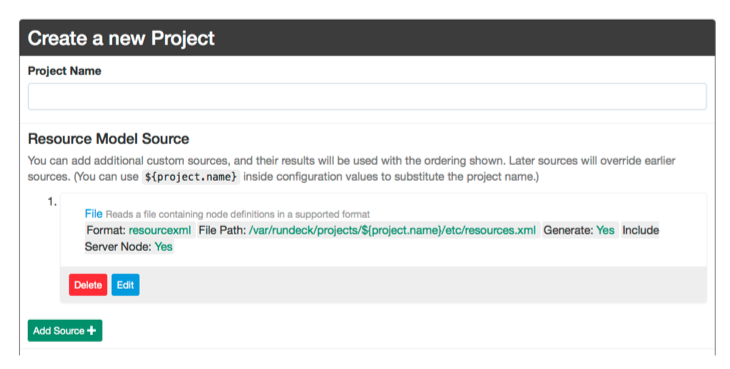Project Create
A project can be created either from the graphical console or using the rd shell tool.
Graphical Interface
In the graphical console, you will notice a Project menu in the navigation bar. If no projects exist, you will be prompted to create a new project.
Press the “New Project” button to create a project.

Basic information
- Name
This is the unique identifier for the project. Project names can contain letters and numbers but do not use spaces or special characters.
- Label
You may wish to use a more user friendly display name for the project. The project label can contain spaces and other characters.
- Description
A brief explanation about the project. Normally, this is just one phrase or sentence explaining the project purpose. If you have large amounts of text, consider creating a project README.
Execution Mode
- Disable Execution
Turn off the ability to execute jobs and ad-hoc commands.
- Disable Schedule
Turn off the job scheduling feature.
User Interface
- Job Group Expansion Level
In the Jobs page, how should the job groups be collapsed? A
1is default and shows one group level opened. Use0to collapse all. Use-1to expand all.- Display the Readme
Show the Readme in the project list and/or home page.
- Display the MOTD
Show the Readme in the project list and/or home page.
Default Node Executor
The Node Executor is responsible for executing commands and scripts on remote nodes. On Linux machines, SSH will be default.
Default File Copier
The File Copier is responsible for copying scripts as files to remote nodes before they are executed. On Linux machines, SCP will be default.
Create
After filling in the project create form, Rundeck initializes it and returns you to the default page (eg, “Jobs”).
Projects can be created at any time by going back to the Project menu and selecting the “Create a new project…” item.
The project setup process generates Project configuration in the server, and a local resource model containing information about the rundeck server node.
Automating
CLI Usage
The rd projects command can be used to script the creation for projects. See the rd projects create help output for syntax usage.
Execute the rd projects create command and specify a project name, here we use “MyProject”:
You can also declare configuration properties when you create the project.
Here a project label and the default SSH key properties are declared as command line options:
rd projects create -p MyProject -- \
--project.label="My Project" \
--project.ssh-keypath=/home/rundeck/.ssh/id_rsaYou can specify a resource model source by specifying keys as command line options, too. Here a Directory model source is also defined.
rd projects create -p MyProject -- \
--project.label="My Project" \
--project.ssh-keypath=/home/rundeck/.ssh/id_rsa \
--resources.source.2.type=directory \
--resources.source.2.config.directory=/home/rundeck/projects/MyProject/resources.dAPI Usage
Project creation can be achieved via the API.
POST /api/13/projects
Content-Type: application/json
{ "name": "MyProject", "config": { "project.label":"My Project" } }